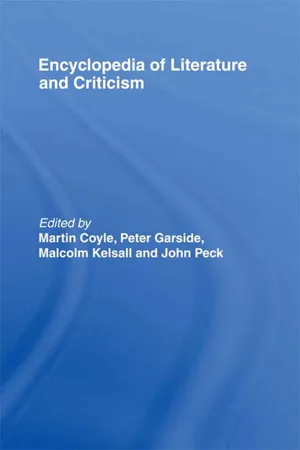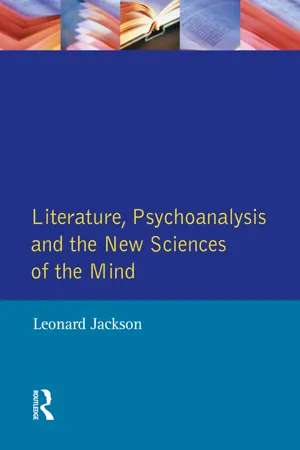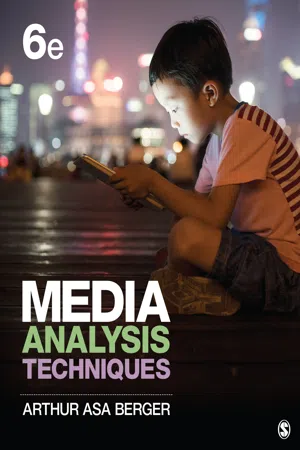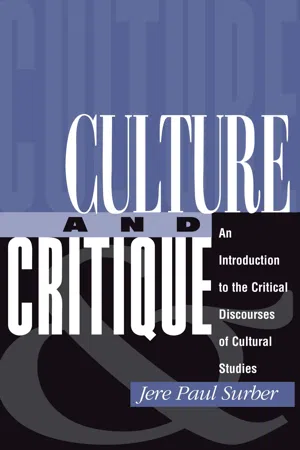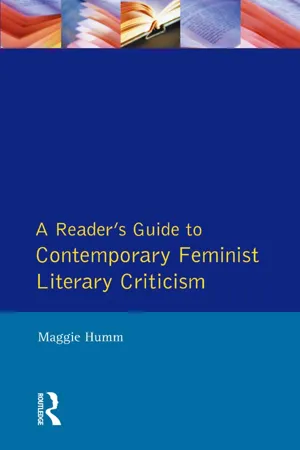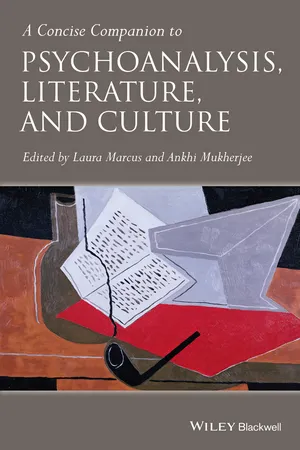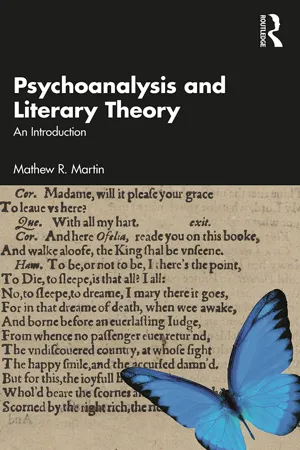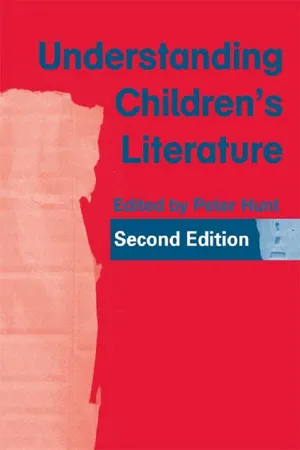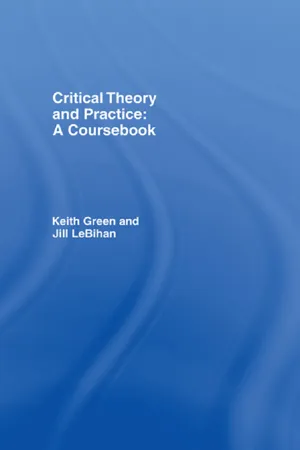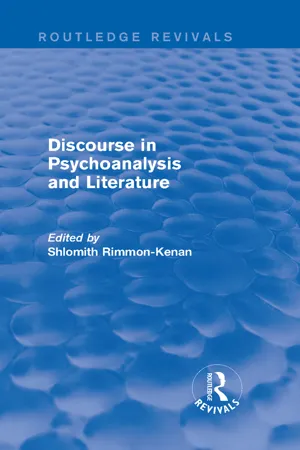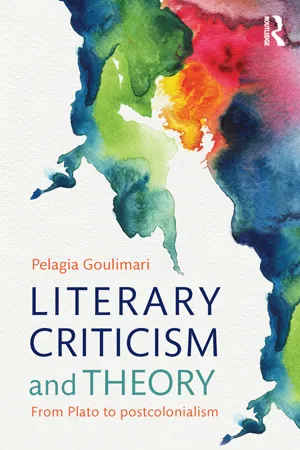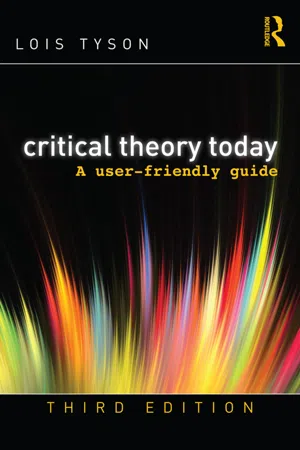Literature
Freudian Criticism
Freudian criticism is a literary theory that applies Sigmund Freud's psychoanalytic principles to the analysis of literature. It focuses on exploring the unconscious motivations and desires of characters, as well as the psychological elements of the author's work. This approach often delves into symbolism, dreams, and the influence of the subconscious mind on the creation and interpretation of literary texts.
Written by Perlego with AI-assistance
Related key terms
12 Key excerpts on "Freudian Criticism"
- eBook - ePub
- Martin Coyle, Peter Garside, Malcolm Kelsall, John Peck(Authors)
- 2002(Publication Date)
- Routledge(Publisher)
A psychoanalytic reading thus crucially involves accounting for the presence of sexuality in the text. This has been done in a number of ways. Historically the process of revealing and theorizing these sexual fantasies has gone through a series of by now familiar stages, moving from the analysis of the unconscious of the author, to that of the reader, to that of the text. These stages involve a changing view of the dynamics of the unconscious, and hence provoke different kinds of readings, based on different ideological assumptions. The field has become so complicated that it is no longer possible to work within a simple tripartite scheme of criticism that is author-based (and its corollary, character-based), reader-based and text-based, because each of these is subject to further divisions which may overlap the three boundaries. Another way of doing it is to use groupings based on theories of the subject rather than on methods by which such theories are applied. The present account is accordingly compiled under the following main headings: (1) Classical Freudian Criticism; (2) Post-Freudian Criticism; (3) Lacanian criticism; (4) Schizoanalysis; (5) Psychoanalytic Feminist Criticism. Within each of these headings there will be some smaller sub-headings.Classical Freudian Criticism
Classical applied psychoanalysis has analysed the literary work as a symptom of a particular artist. This has led to certain well-known presuppositions, such as the work of literature as analogous to a fantasy, within which the literary character is treated as if he or she were a living being and all figures become symbols which are part of a given and rigid code. This approach rests on the assumption that the purpose of the work of art is what psychoanalysis has found to be the purpose of the dream_ the secret gratification of an infantile and forbidden wish. Though it was never claimed that this accounted for the creative writer’s genius, it nevertheless led to a constant uncovering of a predictable content. However, it is often overlooked that psychoanalysis, for all its monotonous rehearsing of a set number of themes, can lead to a better understanding of the complexities of the relation between desire and figuration. Since this relation must involve an analysis of tropes, there is even here already an area where psychoanalysis and the literary text can mutually inform each other, establishing a relation between psychoanalysis and aesthetics.Psychopathography
The classical psychoanalytic critic sees the relationship between author and text as analogous to that between the dreamer and his ‘text’. The aim is to reveal the psychology of the author in terms of his unconscious infantile wishes, the emphasis being on the role played by the drives in accordance with Freud’s dynamic model of the psyche, in which the pleasure principle conflicts with the reality principle. - Leonard Jackson(Author)
- 2014(Publication Date)
- Routledge(Publisher)
5 – but the enterprise is not a nonsensical one. Nor is it entirely nonsensical to do what is now most fashionable – to go one stage further and treat literary criticism as the master discourse, with which one interrogates and analyses the Freudian texts.But there was a time between – stretching, let us say, from about 1910 to 1970 – when Freudian theory was defensible as the best scientific theory of the full complexities of the human mind that we had; and many of the analyses of the mind developed in that period have not been superseded by anything in modern cognitive theory. I am thinking in particular of analyses of types of ego defence. In that time it seemed possible to treat Freudian theory as offering something like a scientific explanation of the way literature works, including the way it is created, and the way it is read; and to treat Freudian literary criticism as an application of a genuinely independent science.Five applications of Freudian theory to literature
Classical Freudian theory appears to be relevant to the theory of literature in at least five ways. It suggests a theory of literary creation, on the lines of dream and symptom formation, in which underlying fantasies are combined with daily experience and with material from the literary tradition, by processes of condensation, displacement, the use of concrete imagery, and the use of pre-existing symbols. This in turn suggests a process of literary interpretation, applied to texts, which attempts to get back to the underlying unconscious material. The two processes taken together suggest a theory of writing and reader-response, which tells us a great deal about how literature functions and what it is for – how it deals with traumatic material, for example. It also provides a theory of universal human nature, in its account of the structure of the mind and the contents of the unconscious; and of the vagaries of individual character, in its extensive library of case studies. This may be the full range of possibilities for explanatory theory. Modern post-Lacanians don’t generally offer new literary applications of Freudian theory; as we shall see in Chapter 7- eBook - ePub
- Arthur A, Berger(Authors)
- 2017(Publication Date)
- SAGE Publications, Inc(Publisher)
Chapter 3 Psychoanalytic CriticismThe Unconscious
Psychoanalytic criticism is a form of applied psychoanalysis, a science concerned with the interaction between conscious and unconscious processes and with the laws of mental functioning. It should not be confused with psychotherapy, which is concerned with treating mental illness and behavioral problems, although many psychotherapists use various kinds of analysis in their work. Rather, psychoanalytic criticism is one of many different forms of study that use psychoanalytic concepts to understand particular subject matter. Thus there are psychoanalytically inclined sociologists, anthropologists, and political scientists, as well as critics, and all of them use concepts and insights from psychoanalytic theory in their work.Freud did not discover the unconscious; Plato, Nietzsche, Bergson, and many others discussed it before Freud. However, Freud developed the concept most thoroughly, and it is with Freud that all neo-Freudians, post-Freudians, anti-Freudians, and non-Freudians must come to grips. Freud was a seminal thinker of incredible power and scope, and his ideas and insights have fueled generations of scholars in numerous fields. What I offer in this section is not a full-scale explication of Freudian thought, but a selection of some of Freud’s most important concepts—concepts that can be applied to the media to help clarify how they work and how they affect us. Freud was most interested in helping people, yet in the course of his amazing career he wrote on many other subjects, such as folklore, humor, and theater—pointing the way toward the development of psychoanalytic criticism.One of the keystones in psychoanalytic theory is the concept of the unconscious. As Freud (1963) writes in his essay “Psychoanalysis,” in Character and Culture - eBook - ePub
Culture And Critique
An Introduction To The Critical Discourses Of Cultural Studies
- Jere Paul Surber(Author)
- 2018(Publication Date)
- Routledge(Publisher)
To complete our survey of the critical discourse of psychoanalysis, brief note must be taken of its widespread appropriation by other creative and critical practices. Like all of the critical discourses that we are considering, psychoanalysis offered a new theoretical framework and vocabulary in which to pose novel questions and explore a range of alternative responses to them. Even in Freud’s own lifetime, some of the basic ideas and themes of psychoanalysis came to influence not only other critical discourses concerned with culture (such as Marxism and the Frankfurt School of critical theory) but also many figures directly involved in cultural production. Among the latter can be counted such authors as Thomas Mann, D. H. Lawrence, and James Joyce; visual artists involved in the Dadaist and Surrealist movements, including Max Ernst and Salvador Dali; and composers such as Arnold Schoenberg, Alban Berg, and Richard Strauss, whose operas explicitly drew on key Freudian notions.Literary criticism (and its cousin, media criticism) has employed psychoanalytic insights in particularly productive ways. While few literary or media critics would consider their approach exclusively psychoanalytic, many have drawn on various psychoanalytic ideas in their attempts to interpret the multiple dimensions of cultural texts. In his book Literary Theory: An Introduction (1983), Terry Eagleton provides a helpful classification of approaches to literary works that have employed psychoanalytic insights. There he distinguishes among psychoanalytic interpretations that focus on a work’s author , its contents , its formal construction , and its reader .As we have seen, Freud himself first pointed the way toward reading cultural texts as manifestations of the unconscious psychic conflicts of the author, suggesting that they be approached by analogy to the manifest content of dreams, that is, as products of the author’s daydreams and fantasies. By a more or less straightforward appropriation of Freud, cultural texts can provide ready examples for exploring the psychodynamics of the individual outside the rarefied context of clinical psychoanalysis. From a more critical perspective, such analyses remind us that cultural products are never completely under the control of even the most deliberate author but reveal a complex interplay between unconscious desire and conscious representation that constantly overruns the author’s intentions. For some critics, psychoanalytic approaches to cultural products indeed help us understand their authors better than those individuals understood themselves. The critical writings of Ernest Jones and Harold Bloom provide some of the best known examples of this approach. Perhaps even more interesting from a critical perspective are attempts to psychoanalyze the collective author of commercial productions such as television series, advertisements, film genres, or political campaigns, where collective patterns of repression and neurosis often manifest themselves. - Maggie Humm(Author)
- 2015(Publication Date)
- Routledge(Publisher)
écriture féminine), it is important to examine this analogy in detail to see how well it can answer the question: is there a woman’s language which speaks of psychic experiences ignored or devalued by the dominant discourse? The discipline of psychoanalysis offers useful starting points. Psychoanalytic criticism articulates a problem that is inherent in all feminist criticism_ that of linking the place of the social with what are private, perhaps even totally individual, feelings.Psychoanalytic criticism is one of the most valuable and fruitful additions to feminist literary theory. If we make a list of the major feminist critics, we find that Kristeva, Cixous and Irigaray from France, Heilbrun, Mary Jacobus, Gilbert and Gubar, Spivak, Hirsch and Felman from America, and Coward and Mitchell from England are all indebted to psychoanalysis, albeit in very different ways. While psychoanalysis is not just about the construction of femininity through language, what psychoanalysis does is to offer a reading of the feminine rooted not entirely in the social construction of femininity (which nevertheless organises the feminine), nor entirely in biology, but through language and subjectivity. Indeed, even in ‘purely’ medical psychoanalysis, case studies of the private lives of women, their fantasies and early experience are initially read as language before being read as medical symptoms. Even those preverbal experiences of the unconscious or the semiotic are constituted linguistically, as it were, by psychoanalysis.Psychoanalytic cases as well as literary criticism have a tendency to be written as texts. Both openly reveal their status as fiction without, of course, abandoning their search for a ‘true’ meaning in the discourse each examines. Psychoanalysis tries to read the ‘text’ of each subject in terms of her dreams and style of speech among other things. To do this, it focuses in particular on ‘literary’ forms – on absences, distortions and slippages – which may provide access to hidden parts of a subject’s personality. Literary criticism does something very similar. By examining metaphors, similes and absences in the literary text it tries to reveal the hidden subtext of an author.- Laura Marcus, Ankhi Mukherjee, Laura Marcus, Ankhi Mukherjee(Authors)
- 2014(Publication Date)
- Wiley-Blackwell(Publisher)
In Freud’s view, literature is not limited to a passing acquaintance with important writers, but entails a serious immersion in the humanities. There is a specific knowledge, with its attendant pedagogy, that can be mastered by a training blending the medical and the humanistic. Literature offers a privileged mode of entrance to “culture,” a term which combines personal engagement with formalized modes of fiction (Bildung). They offer a compendium of values and define a civilization (Kultur). No psychoanalyst can ignore the benefits derived from its acquisition: psychoanalysis is a province of the humanities. Is this what Bayard had in mind with his provocative title? To be sure, his chiasmic reversal aims at questioning critical methods elaborated in the name of psychoanalysis, so as to limit or prevent its “applications” to literature. This critique of the assumptions of standard psychoanalytic criticism comes from someone who is both a psychoanalyst and a professor of literature. He must be in a good position to give voice to a general dissatisfaction with psychoanalytic literary criticism. The current consensus is that psychoanalytic criticism is obsolete. No American graduate program will accept a candidate with a plan to study Hamlet’s inhibitions or examine Dostoevsky’s castration complex. Already in the 1950s, Nabokov vociferously attacked Freud. He was then in a minority when he railed against “the Viennese quack” and derided Freud’s sexual obsession. Indeed, the Freudianized critical literature of the 1950s is painful to read: every steeple is a penis, every vale a vulva. Nabokov’s strictures are now universally shared. What is more, the term “application” sounds like an echo of Bergson’s definition of laughter caused by the “application” of the mechanical to the human- eBook - ePub
Psychoanalysis and Literary Theory
An Introduction
- Mathew R. Martin(Author)
- 2022(Publication Date)
- Routledge(Publisher)
1Freud and Literary Criticism1DOI: 10.4324/9781003219347-2As we saw at the beginning of the introductory chapter, psychoanalysis began with the first piece of psychoanalytic literary criticism, Freud’s interpretation of Sophocles’s Oedipus Rex andShakespeare’s Hamletin light of his childhood memory. Psychoanalysis is “first and foremost an art of interpreting” Freud would later comment in Beyond the Pleasure Principle (1920). As we will see in this chapter, however, the art of psychoanalytic interpretation—psychoanalytic hermeneutics—is challenging: it is challenging in the demands it places on the text or work of art, and its theories and methods challenge many of the key concepts and methods of non-psychoanalytic literary criticism.Oedipus Rex and Hamlet: Mimesis, Tragedy and Catharsis
Freud’s analysis of the Oedipus complex takes us back to some of the oldest concepts in the history of Western literary criticism: mimesis, tragedy and catharsis. In his Poetics, classical Greek philosopher Aristotle (384–322 BCE) defined artistic mimesis as the imitation of “people doing things” (52). These people “must necessarily be either good or bad” (52), Aristotle remarks, and this difference “marks off tragedy from comedy, since the latter aims to represent people as worse, the former as better, than men of the present day” (53). “A tragedy,” he continues, “is a mimesis of a high, complete action” (57). The imitation must be realistic (62), the characters must be noble, and the action or plot must be unified—i.e. it must have a causally connected beginning, middle and end (60–61)—and all other elements of the drama, including character, must be subordinate to it. Significantly, Aristotle argues that “in the particular actions themselves there should be nothing irrational, and if there is it should be outside the tragedy, like that of Sophocles’s Oedipus” (70). Peripeteiai, or reversals of the protagonist’s fortune, brought about by anagnorisis, or a moment of recognition or discovery, and culminating in a scene of pathos “involving destruction or pain” (65) are key elements in the plot of a tragedy, whose ultimate purpose or telos is to provoke the emotions of pity and fear in its audience in order to effect “the catharsis [purging] of such emotions” (57). Having thus defined tragedy as a genre, Aristotle then examines specimens of Greek drama in order to illustrate his definition, and Oedipus is one of his paradigmatic examples. Oedipus himself is precisely the kind of character to create pity and fear in the audience: he is “one who is not pre-eminent in moral virtue, who passes to bad fortune not through vice or wickedness, but because of some piece of ignorance, and who is of high repute and great good fortune” (66). The plot of the play is of the best kind: the irrational is excluded, and the reversal of fortune is brought about by a moment of recognition that is realistic and logical (72). Indeed, the play achieves the cathartic telos of tragedy superlatively, Aristotle declares: it is “so composed that even without seeing the action, a man who just hears what is going on shudders and feels pity because of what happens” (67). Importantly, however, the shudder of pity and fear that the audience experiences is also a spasm of pleasure. “Mimesis - eBook - ePub
- Peter Hunt(Author)
- 2006(Publication Date)
- Routledge(Publisher)
Through the Looking Glass, they forget that she is a linguistic construct, a trope for the unresolved problems of her author (Greenacre 1955). It is important that psychoanalytic critics are aware of the ambivalences inherent in their method and do not seize one aspect of a psychoanalytical theory as a tool for interpretation, thereby reducing the text to universals about human development (compare Hogan 1990; Knoepflmacher 1990; Phillips and Wojcik-Andrews 1990; Steig 1990; Zipes 1990).The following discussion will focus on defining those psychoanalytic theories that have influenced the criticism of children's literature. Frequently such criticism relies on the informal developmental psychological knowledge of the interpreter without reference to any specific theory. This is especially true of realistic narratives for young adults. The strongest psychoanalytic tradition of criticism can be found in the interpretation of folk tales and märchen and, to a lesser extent, in fantasy literature. While Freud, Jung and their disciples have been important in interpretations of children's literature, the poststructuralist influence has not been as prevalent. Quite dominant, however, is the influence of psychological criticism that relates the development of the child character to the social context depicted in psychologically realistic narratives. Perhaps because of the deep issues involved in psychoanalytic criticism, critics of children's literature occasionally seem to screen discussions of psychoanalytical issues with analyses of social contexts, even where the topic is announced as being psychoanalytical (Smith and Kerrigan 1985).Freudian Criticism
Classical Freudian Criticism interprets the work as an expression of psychopathography, as a symptom whose creation provided therapeutic release for the author. In ‘The Relation of the Poet to Daydreaming’ (1908), Freud saw the crucial relationship between child–play/poet–language: - eBook - ePub
- Keith Green, Jill LeBihan(Authors)
- 2006(Publication Date)
- Routledge(Publisher)
Felman is claiming here a necessary connection between psychoanalysis and literature, with literature providing a practice ground for the analyst as well as informing the theoretical principles on which the analytical methodology is based. However, there are some key differences to remember when working with psychoanalysis as a mode of approaching literary texts. In clinical practice there is only the analyst and the patient to consider, but in literature there are a variety areas which one might analyse – what is the ‘patient’ might not always be clear. The areas that a critic might be analysing are listed below, and they will be explored in the rest of this chapter. It’s unlikely that you’ll be able to give firm answers to the following questions. They are speculative rather than practical at this stage, but you might want to reconsider them as you read.i) Does psychoanalysis give us access to the unconscious of the writer? Do we assume that literature is produced almost without the writer’s volition?ii) Does psychoanalysis give us access to the unconscious world of the text? Is there anything that can be revealed by this approach (about the text, its context or its ideological structure) that might otherwise not be available to us?iii) Are we able to make meaningful judgements about a text by looking at the unconscious motives and wishes of characters? Is it appropriate to apply the same analytical techniques to the narrator or implied author as we would to a character?iv) Do psychoanalytic methods give us an insight into our own relationship with a text, as readers or as critics? Can understanding something about our own unconscious help us recognise why we read something in a particular way? Does our critique of a text have an unconscious aspect (that is, we reveal something that we ourselves do not recognise)?3 Freudian psychoanalysis
Freud does not have a coherent body of work, and there is not a single definitive version of his approaches that can be adopted in a straightforward manner, either for literary purposes or for therapeutic ones. There are - Shlomith Rimmon-Kenan(Author)
- 2014(Publication Date)
- Routledge(Publisher)
I The idea of a psychoanalytic literary criticism * PETER BROOKS Psychoanalytic literary criticism has always been something of an embarrassment. One resists labelling as a ‘psychoanalytic critic’ because the kind of criticism evoked by the term mostly deserves the bad name it has largely made for itself. Thus I have been worrying about the status of some of my own uses of psychoanalysis in the study of narrative, in my attempt to find dynamic models that might move us beyond the static formalism of structuralist and semiotic narratology. In general, I think we need to worry about the legitimacy and force that psychoanalysis may claim when imported into the study of literary texts. If versions of psychoanalytic criticism have been with us at least since 1908, when Freud published his essay on ‘Creative writers and daydreaming’ (1953a), and if the enterprise has recently been renewed in subtle ways by post-structuralist versions of reading, a malaise persists, a sense that whatever the promises of their union, literature and psychoanalysis remain mismatched bedfellows – or should I say playmates. The first problem, and the most basic, may be that psychoanalysis in literary study has over and over again mistaken the object of analysis, with the result that whatever insights it has produced tell us precious little about the structure and rhetoric of literary texts. Traditional psychoanalytic criticism tends to fall into three general categories, depending on the object of analysis: the author, the reader or the fictive persons of the text. The first of these constituted the classical locus of psychoanalytic interest. It is now apparently the most discredited, though also perhaps the most difficult to extirpate, since if the disappearance of the author has been repeatedly announced, authorial mutants ceaselessly reappear, as for instance in Harold Bloom’s psychomachia of literary history- eBook - ePub
Literary Criticism and Theory
From Plato to Postcolonialism
- Pelagia Goulimari(Author)
- 2014(Publication Date)
- Routledge(Publisher)
Reading for the Plot, he now mentions Bloom disparagingly, as antithetical to his own project. Bloom’s “psychomachia of literary history” resurrects the disreputable tradition of biographical psychoanalytic criticism (21), while Brooks allies himself with the poststructuralist attention to textuality: “texts and rhetoric rather than authors” (23). However, in Kristeva’s poststructuralist terms, it might be argued that Brooks’s theory of literature and criticism is completely semiotic, at the exclusion of the symbolic, with problematic consequences. Brooks claims to reveal the truth of literature and criticism as symptomatic semiotic repetition of repressed desires, but in making this claim his own theory presents itself as cognitive, exempt from semiotic repetition and completely symbolic. Brooks’s psychoanalytic theory of literary interpretation is thus an odd combination of pretension to knowledge and claim that knowledge is not possible.Conclusion
- Our discussion of Freud outlined his theorization of the self: the Unconscious; the relation between sexuality, resistance and repression; the relation between pleasure principle and reality principle; the role of fantasy and nachtrachlichkeit (“deferred action” or “afterwardsness”). In Freud’s later work, the relation between eros and thanatos (the death instinct); the distinction between id, ego and super-ego; his theorization of melancholia; the 1920s debate on gender within psychoanalysis and the subsequent break in Freud’s theorization of gender. In relation to the formation of dreams, we outlined the processes of displacement, condensation and overdetermination. We discussed transference and counter-transference, in the relation between analysand and analyst.
- Melanie Klein emphasized the relation to the mother and the role of aggression in the psychic life of both men and women. We discussed her distinction between the paranoid-schizoid position and the depressive position.
- We discussed Lacan’s distinction between the imaginary (identifications, misrecognition, fictional direction), the symbolic (symbolic differentiations and the sliding of the signified under the signifier) and the real. We turned to Žižek’s understanding of Lacan’s real, and Žižek’s distinction between the real and reality
- eBook - ePub
Critical Theory Today
A User-Friendly Guide
- Lois Tyson(Author)
- 2014(Publication Date)
- Routledge(Publisher)
psychobabble illustrates our belief that psychoanalysis is both impossible to understand and meaningless. Thus, in a culture that uses psychoanalytic concepts in its everyday language we frequently see the wholesale rejection of psychoanalysis as a useful way of understanding human behavior.I hope this chapter will show you that seeing the world psychoanalytically can be simple without being simplistic. If we take the time to understand some key concepts about human experience offered by psychoanalysis, we can begin to see the ways in which these concepts operate in our daily lives in profound rather than superficial ways, and we’ll begin to understand human behaviors that until now may have seemed utterly baffling. And, of course, if psychoanalysis can help us better understand human behavior, then it must certainly be able to help us understand literary texts, which are about human behavior. The concepts we’ll discuss below are based on the psychoanalytic principles established by Sigmund Freud (1856–1939), whose theory of the psyche often is referred to today as classical psychoanalysis. We must remember that Freud evolved his ideas over a long period of time, and many of his ideas changed as he developed them. In addition, much of his thinking was, as he pointed out, speculative, and he hoped that others would continue to develop and even correct certain of his ideas over time. So the attempt in this chapter is to outline those areas of classical psychoanalytic theory that are particularly useful to literary criticism and to show how this view of human behavior is relevant to our experience of literature. Later in the chapter, we’ll also take a brief look at the more recent work of nontraditional psychoanalytic theorist Jacques Lacan.1
Index pages curate the most relevant extracts from our library of academic textbooks. They’ve been created using an in-house natural language model (NLM), each adding context and meaning to key research topics.
